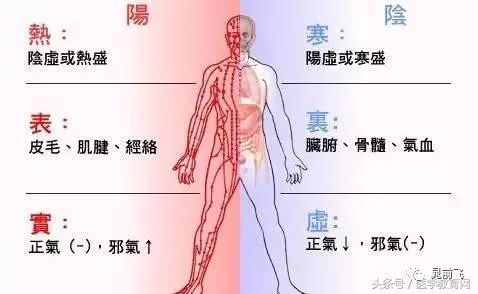This article is sourced from the “Medical Education Network”.
Understanding the Eight Principles of Diagnosis is equivalent to stepping into the realm of Traditional Chinese Medicine (TCM).
Moreover, those who understand the Eight Principles are more adept at moxibustion.
The Eight Principles of Diagnosis are based on the “Huangdi Neijing” (Yellow Emperor’s Inner Canon) and are applied in the “Shanghan Zabing Lun” (Treatise on Cold Damage and Miscellaneous Diseases). The Ming Dynasty scholar Zhang Jingyue stated in the “Jingyue Quanshu” (Complete Works of Jingyue): “In diagnosing and treating diseases, one must first examine Yin and Yang; understanding this allows one to grasp all diseases.”
The Eight Principles of Diagnosis are the core of TCM philosophy and the soul of TCM culture. Understanding the Eight Principles is akin to having one foot already in the hall of TCM. Yesterday, we shared an article discussing common misconceptions in moxibustion. In fact, many practitioners encounter basic errors during moxibustion due to a lack of understanding of the Eight Principles of Diagnosis. In other words, understanding the Eight Principles will enhance your knowledge of moxibustion, whether you are performing it on yourself or guiding others, which is immensely helpful.
The Eight Principles of Diagnosis categorize various diseases into eight major types: Yin, Yang, Exterior, Interior, Cold, Heat, Deficiency, Excess. This serves as the theoretical foundation for syndrome differentiation and treatment. The eight types of diseases are derived from the information gathered through the four examinations of the patient, and are analyzed based on the patient’s constitution, the severity and nature of the disease, and the depth of the disease location.

Among these eight principles, Yin and Yang reflect the categories of diseases, Exterior and Interior reflect the depth of the disease, Cold and Heat reflect the nature of the disease, and Deficiency and Excess reflect the balance of pathogenic and righteous Qi. Specifically, the content of the Eight Principles of Diagnosis is as follows:
1. Yin-Yang Diagnosis
Yin and Yang are the overarching principles of the Eight Principles. Yin syndromes include Deficiency, Interior, and Cold, while Yang syndromes include Excess, Exterior, and Heat.
Yin syndromes primarily refer to Deficiency Cold syndromes, clinically manifested as fatigue, lack of energy, pale complexion, cold limbs, lack of thirst, and clear diarrhea. Yang syndromes primarily refer to Excess Heat syndromes, clinically manifested as restlessness, constipation, fever, coarse breathing, and short, red urine.
Yin or Yang deficiency can lead to Yin Deficiency or Yang Deficiency. Clinical manifestations of Yin Deficiency include tidal fever, night sweats, weight loss, low-grade fever, five hearts heat, and thin, rapid pulse; Yang Deficiency manifests as fatigue, lack of thirst, shortness of breath, and cold limbs.
When Yin or Yang deficiency reaches a certain level, it can lead to the loss of Yin or Yang, indicating a critical state due to excessive depletion of Yang Qi or Yin Qi. Loss of Yin is characterized by warm hands and feet, sticky sweat, hot skin, and a rapid, weak pulse; Loss of Yang is characterized by profuse sweating, cold sweat, coma, and aversion to cold.
2. Deficiency-Excess Diagnosis
Deficiency and Excess reflect the balance of pathogenic Qi. Excess syndromes indicate strong pathogenic Qi that should be attacked; Deficiency syndromes indicate insufficient righteous Qi that should be tonified.
Deficiency syndromes refer to symptoms arising from insufficient righteous Qi in the body, including varying degrees of damage to the organs, Yin, Yang, and blood. Clinical manifestations include pale complexion, fatigue, palpitations, shortness of breath, frequent urination or incontinence, mental fatigue, and night sweats.
Excess syndromes refer to symptoms caused by excessive pathogenic Qi, resulting from invasion of the body or dysfunction of internal organs. Clinical manifestations include coarse breathing, chest tightness, difficulty urinating, constipation, abdominal distension and pain, and thick, greasy tongue coating.
Distinguishing between Deficiency and Excess generally follows these rules: strong body, old tongue, early to mid-stage of external diseases, loud voice, strong pulse, and pain that resists pressure are often Excess syndromes; weak body, tender tongue, late stage of external diseases, weak voice, weak pulse, and pain that prefers pressure are often Deficiency syndromes.
Deficiency and Excess can also be further classified into true and false. Generally, abdominal distension that is intermittent or reduces with pressure, and a wiry pulse that is weak indicates true Deficiency and false Excess; while lack of appetite but able to eat, abdominal distension with increased pain upon pressure, and a pulse that is deep but strong indicate false Deficiency and true Excess.
3. Exterior-Interior Diagnosis
Exterior and Interior are relative concepts that reflect the depth of the disease and its location. Exterior syndromes primarily refer to diseases that are relatively superficial and mild, while Interior syndromes refer to diseases that are deep and severe.
Exterior syndromes refer to symptoms arising when the six excess pathogenic factors invade through the mouth, nose, and skin, often occurring in the early stages of external diseases, characterized by sudden onset and short duration. Clinical manifestations include fever, aversion to cold, floating pulse, headache, body aches, nasal congestion, cough, runny nose, and sore throat.
Interior syndromes refer to symptoms that occur when the disease penetrates deeply into the organs, marrow, Qi, and blood, often occurring in the later stages of external diseases or in cases of internal injury, with a generally longer course. Clinical manifestations include constipation, diarrhea, irritability, dizziness, and a deep pulse.
Distinguishing between Exterior and Interior syndromes is generally done by observing changes in the disease’s cold-heat, pulse, and tongue. Specifically, a floating pulse is often indicative of an Exterior syndrome, while a deep pulse is indicative of an Interior syndrome; fever with aversion to cold is often an Exterior syndrome, while fever without aversion to cold is often an Interior syndrome; minimal changes in tongue coating are indicative of an Exterior syndrome, while significant changes are indicative of an Interior syndrome.
4. Cold-Heat Diagnosis
Cold and Heat indicate the nature of the disease. Generally, Yang excess indicates Heat syndromes, while Yin excess indicates Cold syndromes.
Cold syndromes are characterized by cold nature, often accompanied by reduced organ function, clinically manifested as pale complexion, loose stools, aversion to cold, and cold limbs; Heat syndromes are characterized by heat nature, often accompanied by excessive organ function, manifested as short, red urine, flushed face, restlessness, and aversion to heat.
Distinguishing between Cold and Heat syndromes can be challenging due to some deceptive presentations. Generally, aversion to cold with preference for warmth, lack of thirst, pale complexion, and cold limbs indicate Cold syndromes; aversion to heat with preference for cold drinks, thirst, flushed face, and warm limbs indicate Heat syndromes.
Sometimes, the manifestations of Cold and Heat can be misleading, requiring careful observation. Generally, thirst with preference for warm drinks, body heat with preference for covering, flushed face that appears intermittently, and a large but weak pulse indicate true Cold and false Heat; while cold hands and feet with a deep pulse, cold limbs with body heat and no aversion to cold, and a deep but strong pulse with thirst that prefers cold drinks indicate true Heat and false Cold.
Summary of Learning: Yin-Yang, Deficiency-Excess, Exterior-Interior, Cold-Heat—these four relationships together form the “guidelines” of the Eight Principles of Diagnosis. Therefore, Yin-Yang diagnosis is the core of the Eight Principles. Any disease at any time can be categorized under these eight principles of Yin-Yang, Deficiency-Excess, Exterior-Interior, and Cold-Heat. Thus, this article is written with the hope of providing practical help to TCM practitioners and moxibustion enthusiasts. If you find it helpful, please share it with your friends and family. Let everyone “gain knowledge” together!

Appendix: Song of the Eight Principles of Diagnosis
Exterior Syndrome Song
When the disease is in the exterior, remember this: fever, aversion to cold, nasal congestion.
Headache, body aches, floating pulse, thin white tongue coating, sore throat, cough.
Interior Syndrome Song
For distinguishing external and internal syndromes, observe carefully: high fever, irritability, delirium.
Abdominal pain, constipation, red urine, flushed face, rapid pulse, yellow tongue coating.
Heat Syndrome Song
Heat syndrome presents with a flushed face, dry lips, and constipation.
Thirst with preference for cool drinks, rapid pulse, chest discomfort, and a feeling of heat.
Cold Syndrome Song
In cold syndrome, lips and face are pale, aversion to cold, preference for warmth.
Cold limbs, curled up posture, thin phlegm, clear urine, and loose stools.
Yang Qi Deficiency Song
Pale complexion indicates Yang Qi deficiency, fatigue, excessive sweating.
Reluctance to speak, shortness of breath, pale tongue, cold limbs, and weak pulse.
Yin Blood Deficiency Song
Dizziness, thin physique, five hearts heat, night sweats, red cheeks, dry mouth.
Numbness, spasms, thin tongue coating, careful observation of Yin and blood deficiency.
Excess Syndrome Song
Excess syndromes are strong, with abundant pathogenic Qi, coarse breathing, and phlegm.
Abdominal distension, pain that resists pressure, feeling of burning, and difficulty with urination.
Phlegm, blood stasis, food stagnation, and water retention are also related.


